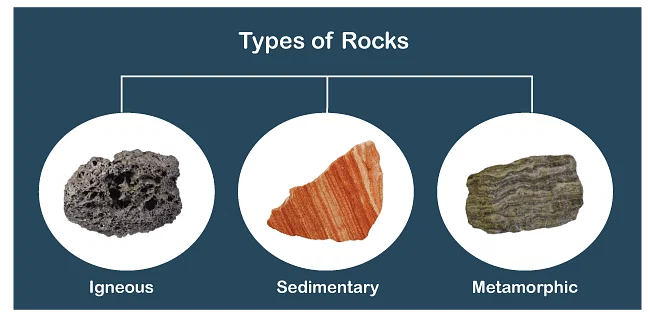Our planet is mostly made of solid rock. Rock is what
gives Earth its features—mountains, canyons, and plains.
Minerals are the building blocks of every type of rock.
Most of Earth’s rocks are hidden under a layer of soil and vegetation, but in some places they are visible at the surface, in landscape features such as mountains and canyons. Many different types of rock have developed over billions of years, through a variety of processes. These include volcanic activity, which creates rocks at or near the surface, the formation of ediments in places like the seafloor, and changes in form—called metamorphism—brought about by heat and pressure deep within our planet. These processes are linked in a never-ending cycle, known as the rock cycle.
The Earth is composed of a variety of rocks, which can be broadly categorized into three main types: igneous, sedimentary, and metamorphic rocks. These rocks are classified based on their formation processes and characteristics.
Igneous Rocks:
Igneous rocks are formed from the cooling and solidification of molten material, known as magma or lava. There are two main types of igneous rocks:
a. Intrusive Igneous Rocks: These rocks form beneath the Earth’s surface as magma cools and solidifies slowly. The slow cooling allows large mineral crystals to develop. Examples include granite and diorite.
b. Extrusive Igneous Rocks: These rocks form on the Earth’s surface as lava cools and solidifies quickly. The rapid cooling results in smaller mineral crystals or even glassy textures. Examples include basalt and pumice.
Sedimentary Rocks:
Sedimentary rocks are formed from the accumulation and cementation of sediments, which can include mineral fragments, organic materials, and chemical precipitates. These sediments are often derived from the erosion of pre-existing rocks. There are three main types of sedimentary rocks:
a. Clastic Sedimentary Rocks: These rocks are formed from the compression and cementation of mineral and rock fragments. Examples include sandstone, shale, and conglomerate.
b. Chemical Sedimentary Rocks: These rocks form from the precipitation of minerals from solution. Examples include limestone (formed from calcium carbonate), rock salt (halite), and gypsum.
c. Organic Sedimentary Rocks: These rocks are primarily composed of organic materials, such as plant remains and shells. Examples include coal (formed from plant material) and certain types of limestone with abundant fossil shells.
Metamorphic Rocks:
Metamorphic rocks are formed from pre-existing rocks (igneous, sedimentary, or other metamorphic rocks) that have been subjected to high temperatures and pressures deep within the Earth’s crust. This process causes mineralogical and textural changes without melting the rock completely. There are two main types of metamorphic rocks:
a. Foliated Metamorphic Rocks: These rocks have a layered or banded appearance due to the alignment of mineral grains under pressure. Examples include slate, schist, and gneiss.
b. Non-foliated Metamorphic Rocks: These rocks lack a distinct layered structure and typically form in environments with less directed pressure. Examples include marble (from limestone) and quartzite (from sandstone).
These three types of rocks are constantly being formed, transformed, and recycled through geological processes such as erosion, tectonic activity, and the rock cycle.






























